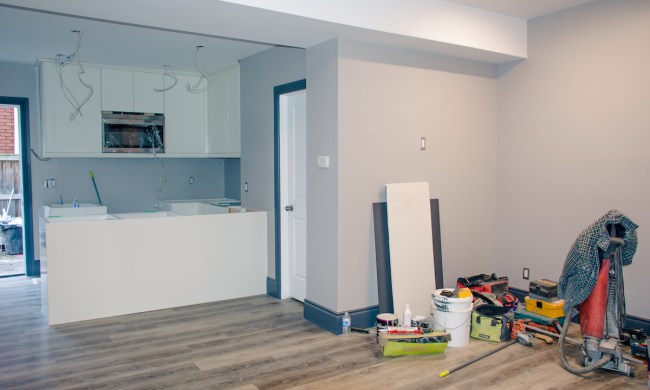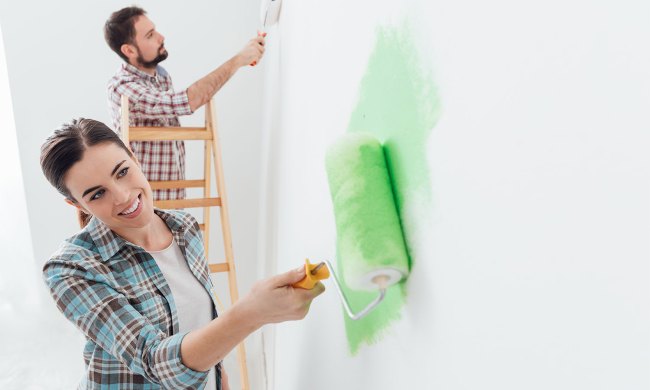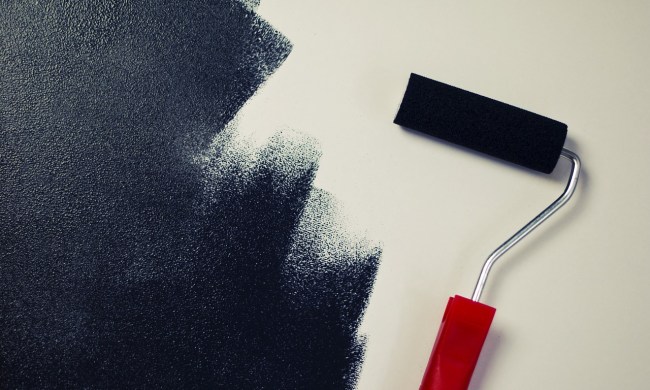If you’re diving into home renovations, you’ve probably come across the option of engineered wood. This versatile material has gained popularity in construction and home improvement projects for its strength, durability, and cost-effectiveness. But what is engineered wood, and what are the benefits and drawbacks of using it?
We’re going to explore what engineered wood is and the different types available, and weigh the pros and cons to help you make an informed decision for your next project.
What is engineered wood?

Engineered wood is a manufactured — or human-made — wood product created by binding or fixing the strands, particles, fibers, or veneers of wood together with adhesives or other methods. This results in a product that can be designed to meet specific performance standards, often surpassing those of natural wood. Engineered wood is used in a variety of applications, from classic hardwood flooring to minimalist wood furniture, and offers several advantages over traditional lumber.
Types of engineered wood

There are several types of engineered wood, each with unique properties and uses. Understanding these types can help you choose the best material for your specific needs.
1. Plywood
Plywood is one of the most well-known types of engineered wood. It’s made by gluing together thin layers of wood veneers, with each layer’s grain direction perpendicular to the adjacent layers. This cross-graining technique improves strength and reduces the risk of splitting when nailed at the edges. Due to its durability and versatility, plywood is commonly used in construction for walls, roofing, and flooring.
2. Composite board
Composite board, also known as engineered wood composite, is made from wood fibers, sawdust, and other wood byproducts mixed with a resin binder. This mixture is then heated and pressed into sheets. Composite boards are often used in furniture making and wood kitchen cabinets because they are a cost-effective choice and are easy to machine and paint.
3. Particleboard
Particleboard is a type of engineered wood made from wood chips, sawdust, and other wood particles that are bonded together with a synthetic resin. The mixture is pressed and extruded to form sheets. Particle board is commonly used in furniture and shelving, particularly in budget-friendly and ready-to-assemble products. While it is not as strong as plywood, it is more affordable and has a smoother surface that’s ideal for veneer finishes.
4. Oriented strand board
Oriented strand board (OSB) is created by compressing layers of wood strands (flakes) with adhesives in specific orientations. OSB is known for its strength and is widely used in construction for wall sheathing, flooring, and roof decking. It’s a more affordable alternative to plywood, though it is often criticized for its rough texture and susceptibility to moisture damage if not properly sealed.
5. Laminated veneer lumber
Laminated veneer lumber (LVL) is made by bonding thin wood veneers together under heat and pressure, with the grain of all veneers running parallel. This process creates a strong and uniform material that is commonly used for beams, headers, and other structural applications where high strength is required. LVL is valued for its ability to span long distances without bending or warping.
6. Laminated strand lumber
Laminated strand lumber (LSL) is similar to LVL but uses wood strands instead of veneers. These strands are aligned and bonded together to form a strong and stable material. LSL is used in a variety of structural applications, including framing, beams, and rim boards. It offers excellent strength and stability, making it a reliable choice for load-bearing applications.
7. Cross-laminated timber
Cross-laminated timber (CLT) is made by stacking layers of wood boards in alternating directions and bonding them together with structural adhesives. This cross-grain construction provides exceptional strength and rigidity, making CLT an excellent choice for large-scale construction projects, including multistory buildings. CLT is praised for its sustainability and ability to be prefabricated, reducing construction time and waste.
8. Medium and high-density fiberboard
Medium-density fiberboard (MDF) and high-density fiberboard (HDF) are made from wood fibers that are bonded together with resin under heat and pressure. MDF has a smooth surface and is easy to machine, making it popular for cabinetry, decorative wood furniture, and decorative crown moldings. HDF is denser and stronger than MDF, making it suitable for more demanding applications, such as flooring and door panels.
Pros and cons of engineered wood

Engineered wood offers several advantages over traditional solid wood, but it also has some drawbacks. Here’s a look at the pros and cons.
Pros
- Stability: Engineered wood is less prone to warping, shrinking, and expanding compared to solid wood, making it a more stable choice for construction and furniture.
- Cost-effectiveness: Many types of engineered wood are more affordable than solid wood, making them an attractive option for budget-conscious projects.
- Versatility: Engineered wood can be manufactured in various sizes, shapes, and finishes, providing greater design flexibility.
- Sustainability: Engineered wood often uses wood byproducts and less high-quality wood, reducing waste and the demand for solid wood.
Cons
- Moisture sensitivity: Some types of engineered wood, such as particleboard and OSB, can be susceptible to moisture damage if not properly sealed.
- Strength: While many engineered wood products are strong, they may not always match the strength and durability of high-quality solid wood.
- Appearance: Engineered wood may lack the natural beauty and unique grain patterns of solid wood, which can be a drawback for aesthetic applications.
Engineered wood is a versatile and often cost-effective alternative to solid wood, offering a range of options to suit various needs and preferences. By understanding what engineered wood is and the types available, you can make an informed decision for your next construction or home improvement project. Whether you prioritize stability, affordability, or sustainability, engineered wood has something unique to offer.




